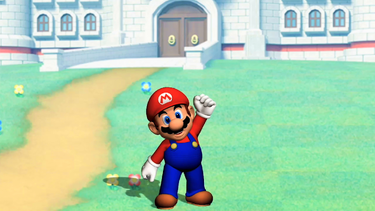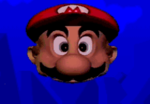Mario in Real Time
Mario in Real Time (more commonly known as MIRT) is an interactive system developed by SimGraphics and introduced in 1991,[1][2] and has since been used by Nintendo across various promotional events. Thought up by SimGraphics CTO Mike Fusco,[3][4] MIRT is notable for being Charles Martinet's first role as Mario (prior to his video game debut in Mario Teaches Typing).
The system, based on Fusco's VActor technology, allows an actor (almost always Martinet), to communicate with passerbys as Mario, along side other characters, such as Luigi, and formerly Wario and Donkey Kong.
MIRT has been repeatedly used by Nintendo throughout the years for promotional events all the way up to present day, modern examples including San Diego Comic-Con 2012 and the Nintendo New York Luigi's Mansion: Dark Moon launch event in New York in 2013 (the former having featured Martinet (as Mario) answering questions from fans,[5] while the latter involved Luigi welcoming fans to the Dark Moon launch event.[6]
History
Developed by Mike Fusco, SimGraphics' VActor technology was pitched to multiple companies as a form of promotion, including Nintendo, who quickly took interest and contracted them to create a system featuring Mario based on the technology.[3][4] Auditions were overseen by the producer who ran the events MIRT would appear in,[4] in tandem with Don James, executive vice president of operations for Nintendo of America.[7] As the audition was ending it was crashed by Charles Martinet, who managed to convince the producer to let him try out. According to Martinet the producer was seemingly annoyed by his performance by the time he left, but purportedly called James immediately to urge him that only Martinet's audition be sent to Japan.[7]
He was very quickly hired, and flown out to do shows through MIRT,[8] though it was quickly found that the incredibly long shifts were too much, so by Charles' suggestion Stevie Coyle was hired as a voice match for several early shows,[2][9] though he would step away from acting in general a few years later. At this time the system had Mario, and later Wario and Donkey Kong, who were added after the release of Wario Land: Super Mario Land 3 and Donkey Kong Country, respectively.[10][11] Both were performed by Martinet solely after Coyle's departure.
Around 2000, Donkey Kong was removed from the system, and Mario and Wario were updated to their current designs.[12][13][14] More notably however, expressions and mouth movement became automatized, which meant face tracking equipment was no longer needed, allowing the characters' full bodies to be rendered, and Martinet to perform from anywhere in the world.[15] Mario and Wario remained as the sole characters until 2012, when Wario was removed but Luigi was added (first appearing at the aforementioned San Diego Comic-Con 2012), along side another overhaul of the system.
Today MIRTs been retired from event appearances, and is used exclusively for promotion at Nintendo New York, most often during the holiday season.[16][17]
Function
MIRT displays Mario on a screen, through which he can talk to those attending the trade fair. Charles Martinet himself (with substitute Stevie Coyle)[9] works the device, standing out of view and reciting Mario's lines, which are instantly reiterated by the character. Martinet also provides Mario's movement through sensors courtesy of Simgraphics Engineering, who developed the VActor technology on which MIRT works. (Mario sound effects and various impossible movements are also available to Martinet).[18] Although Martinet is hidden from the audience, he can see and hear them through a hidden camera and microphone. In addition to trade shows, an early Mario in Real Time was used to animate Mario's face in Mario Teaches Typing and its sequel.
Gallery
Shigeru Miyamoto and a Mario mascot, standing in front of a MIRT display
References
- ^ https://twitter.com/CharlesMartinet/status/1493266234644779012?s=09
- ^ a b Template:Media link
- ^ a b SimGraphics homepage.
- ^ a b c Guinness World Records (December 13, 2018). Charles interviewed on GWR podcast. YouTube. Retrieved Febuary 7, 2023.
- ^ Patrick Scott Patterson (July 16, 2012). Mario reveals his last name & other tales - San Diego Comic Con 2012. YouTube. Retrieved May 8, 2016.
- ^ CubedLink (March 27, 2013). Luigi's welcome at the 'Luigi's Mansion: Dark Moon' Nintendo World launch. YouTube. Retrieved May 8, 2016.
- ^ a b Interview with Charles Martinet.
- ^ http://www.gooddealgames.com/interviews/int_Charles_Martinet.html
- ^ a b DigitalNeohuman (April 23, 2010). Real Time Mario at the 1992 SCES. YouTube. Retrieved April 19, 2013.
- ^ https://www.youtube.com/watch?v=vaquvsK0u40
- ^ https://www.youtube.com/watch?v=NcdkFsVFzMI
- ^ https://www.youtube.com/watch?v=9ihWsOcbS_E
- ^ https://www.youtube.com/watch?v=rA4u6BkHBgc
- ^ https://www.youtube.com/watch?v=iXzTFIL6tPU
- ^ https://www.youtube.com/watch?v=9ABOLF2htwE
- ^ https://twitter.com/NintendoNYC/status/935641539317063681
- ^ https://twitter.com/nintendonyc/status/1073952261833936896
- ^ n8phin (June 10, 2006). Mario's movie impressions at E3. YouTube. Archived from the original on November 4, 2007 via Wayback Machine.





